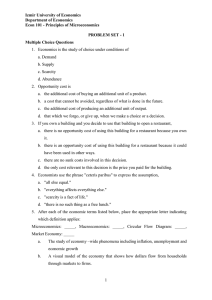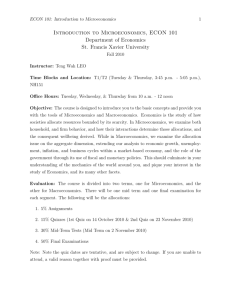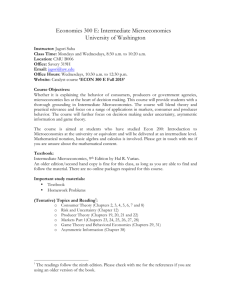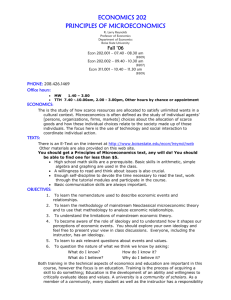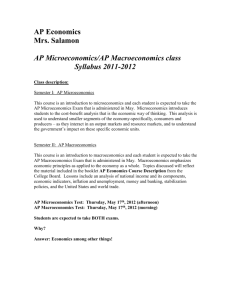Problem Set 1
advertisement
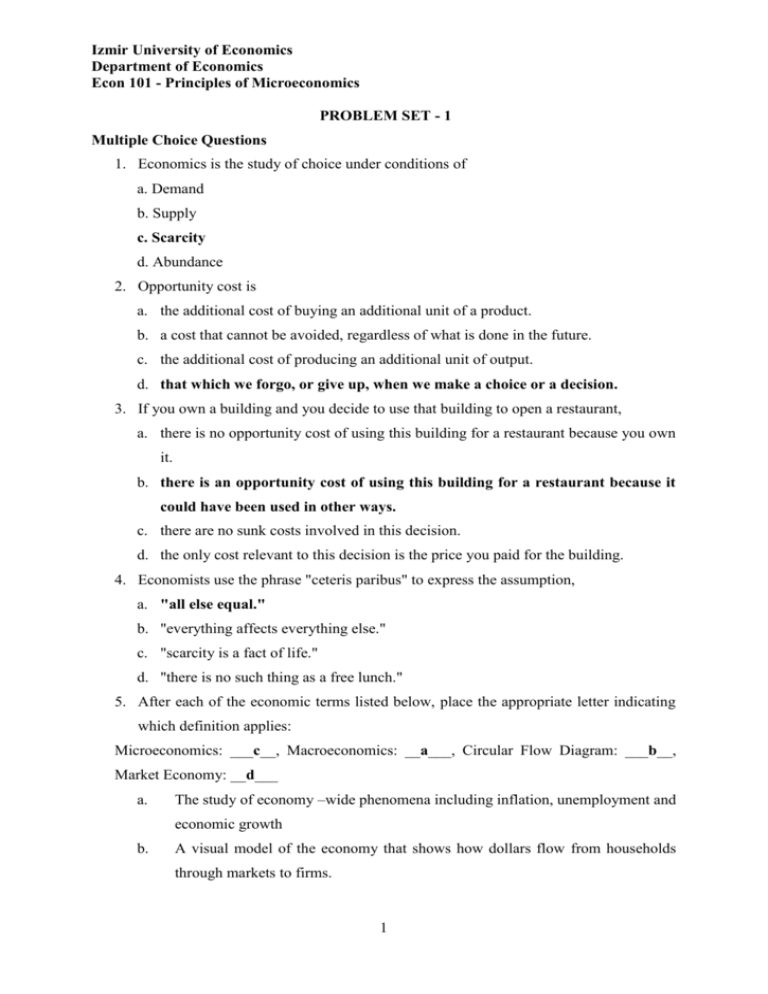
Izmir University of Economics Department of Economics Econ 101 - Principles of Microeconomics PROBLEM SET - 1 Multiple Choice Questions 1. Economics is the study of choice under conditions of a. Demand b. Supply c. Scarcity d. Abundance 2. Opportunity cost is a. the additional cost of buying an additional unit of a product. b. a cost that cannot be avoided, regardless of what is done in the future. c. the additional cost of producing an additional unit of output. d. that which we forgo, or give up, when we make a choice or a decision. 3. If you own a building and you decide to use that building to open a restaurant, a. there is no opportunity cost of using this building for a restaurant because you own it. b. there is an opportunity cost of using this building for a restaurant because it could have been used in other ways. c. there are no sunk costs involved in this decision. d. the only cost relevant to this decision is the price you paid for the building. 4. Economists use the phrase "ceteris paribus" to express the assumption, a. "all else equal." b. "everything affects everything else." c. "scarcity is a fact of life." d. "there is no such thing as a free lunch." 5. After each of the economic terms listed below, place the appropriate letter indicating which definition applies: Microeconomics: ___c__, Macroeconomics: __a___, Circular Flow Diagram: ___b__, Market Economy: __d___ a. The study of economy –wide phenomena including inflation, unemployment and economic growth b. A visual model of the economy that shows how dollars flow from households through markets to firms. 1 Izmir University of Economics Department of Economics Econ 101 - Principles of Microeconomics c. The study of how households and firms make decisions and how they interact in markets. d. An economy that allocates resources through the decentralized decisions of many firms and households as they interact in markets for goods and services. 6. Which of the following is a normative statement? a. Galatasaray won its 8th games this year after the match against Trabzonspor. b. The Consumer Price Index rose three- tenths of one percent in May. c. In January, the average temperature in Çeşme exceeds the average temperature in Bodrum. d. Fenerbahçe needs a better manager even though they scored 6 goals in the last match. e. Turkey’s trade deficit reached an all-time high last year. 7. Şenay is considering attending a movie with a ticket price of $35. She estimates that the cost of driving to the movie and parking there will be an additional $20. In order to attend the movie, Şenay will have to take time off from his part-time job. She estimates that she will lose 5 hours at work, at a wage of $6 per hour. Şenay’s total cost of attending the movie equals: a. 35 b. 55 c. 85 d. 90 e. 105 8. Indicate whether each of the following statements applies to microeconomics or macroeconomics: a. The unemployment rate in Germany was 4.2 percent in January 2001. Macroeconomics b. Vestel laid off 15 workers last month. Microeconomics c. An unexpected freeze in İzmir reduced the citrus crop and caused the price of cotton to rise. Microeconomics d. Turkey’s output, adjusted for inflation, grew by 5 percent in 2003. Macroeconomics e. A sudden shift in interest from skiing to skating increased the price of skateboards. Microeconomics 2 Izmir University of Economics Department of Economics Econ 101 - Principles of Microeconomics f. As a profit-maximizing firm, Alpha Food is producing 2000 cans of food per month. Microeconomics 9. A graph showing all combinations of two goods and services a society could produce if it used all of its resources efficiently is the a. production possibility frontier. b. capital consumption frontier. c. Lorenz curve d. circular-flow diagram. Refer to the information provided in Figure 1 below to answer the questions that follow. 10. According to Figure 1, the point where only cars are produced is a. A b. B c. D d. E 11. According to Figure 1, which point cannot be obtained with the current resources and state of technology? a. C b. A c. D d. F 12. Jim states that the melting of the polar icecap will cause prices in the stock market to increase. He is committing the a. fallacy of inductive reasoning. b. post hoc, ergo propter hoc fallacy. c. fallacy of composition. d. ceteris paribus fallacy. 13. Since Becky plays basketball well, therefore the other members of her team must also play basketball well. This statement is an example of the a. b. c. d. inductive reasoning. ceteris paribus post hoc, ergo propter hoc. fallacy of composition. 3 Izmir University of Economics Department of Economics Econ 101 - Principles of Microeconomics Essay Questions 1) Referring to the table below, answer the following questions. Production Alternatives Product A B C D E Pizza 0 2 4 6 8 Pepsi 14 12 9 5 0 a) Illustrate the data in the table in graphical form b) Suppose that this economy is producing at point C. What will be the opportunity cost moving from C to D? …from C to B? Explain the law of increasing opportunity cost. From C to D: we get additional 2 pizza at a cost of 4 less pepsi From C to B: we get additional 3 pepsi at a cost of 2 less pizza c) Suppose that at a new point F, the economy produces 3 pizzas and 9 pepsis. What does F indicate? INEFFICIENT POINT d) Suppose that a new point G is outside the production possibility curve (PPC). What does this point indicates? “10 pizza – 7 pepsi” : NOT ATTAINABLE !! e) What would cause an outward shift of the PPC? ECONOMIC GROWTH : new resources or technological change & innovation (discovery and application of new more efficient production techniques) 2) Answer following questions referring to the table below. Company/Product Corn Wheat A 8 10 B 4 12 a) Determine which company has absolute advantage for each product Company A has absolute advantage in CORN production, whereas Company B has in WHEAT production. 4 Izmir University of Economics Department of Economics Econ 101 - Principles of Microeconomics b) Determine which company has comparative advantage for each product Company A: 1 C = 1.25 W Company B: 1 C = 3 W Since company A has a lower opportunity cost, has a comparative advantage on CORN production, whereas with a higher opportunity cost company B has comparative advantage on WHEAT production as well. 5

